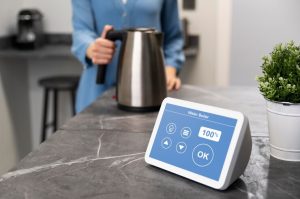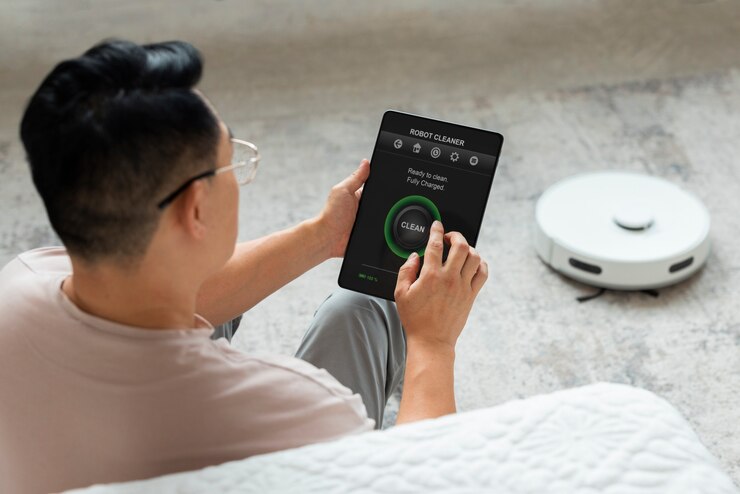In recent years, the realm of smart home technology has experienced a revolutionary transformation, significantly altering how we interact with our living spaces. As technology advances, our homes have become smarter, more efficient, and seamlessly connected. From entertainment systems that can be controlled from a smartphone to advanced security devices that enhance our safety, the integration of smart home solutions into our daily lives has provided numerous benefits. In this comprehensive article, we will delve into various aspects of smart home technology, including entertainment, security, climate and energy management, lighting, and how the Matter standard is reshaping smart home solutions. We will also provide examples, benefits, analysis tables, and competitive comparisons to illustrate the impact of these technologies.
1. Entertainment: The Future of Home Leisure

The entertainment sector has been significantly influenced by smart home technology, providing a wealth of options for consumers. Today’s smart TVs, streaming devices, and audio systems offer seamless integration and user-friendly interfaces that enhance our viewing and listening experiences.
Example: Smart TVs and Streaming Devices
Smart TVs, such as the latest models from Samsung, LG, and Sony, come equipped with built-in streaming services like Netflix, Hulu, and Amazon Prime. These devices can be controlled via voice commands or smartphone apps, allowing users to access their favorite shows and movies effortlessly. The smart TV experience is further enhanced with features such as screen mirroring and voice search, making it easy to find and watch desired content.
Benefits of Smart Entertainment Systems:
- Convenience: Users can control their entire entertainment system with voice commands or a single remote, eliminating the need for multiple remotes cluttering the living room.
- Integration: Smart devices can be linked together to create a unified experience, such as syncing your TV with smart lights for an immersive movie night, where lights dim automatically when a film starts.
- Customization: Personalized recommendations based on viewing habits enhance user experience, ensuring viewers discover new content tailored to their interests.
Analysis Table: Comparison of Popular Smart TVs
| Feature | Samsung QLED | LG OLED | Sony Bravia |
|---|---|---|---|
| Display Technology | QLED | OLED | OLED |
| Voice Control | Bixby, Alexa | Google Assistant | Google Assistant |
| Streaming Services | Yes | Yes | Yes |
| Screen Size Options | 43″-85″ | 48″-77″ | 55″-85″ |
| Price Range | $600-$4,000 | $1,200-$3,500 | $1,300-$3,000 |
| Additional Features | Adaptive Picture | Dolby Vision | XR OLED Contrast |
2. Security and Awareness: Ensuring Safety
As our homes become smarter, the need for enhanced security and awareness grows. Smart security systems provide innovative solutions to help monitor and protect our living spaces. With the capability to receive real-time alerts and remote monitoring, homeowners can maintain a watchful eye over their properties, even when they are away.
Example: Smart Security Cameras
Devices like the Ring Video Doorbell and Arlo Pro cameras empower users to monitor their properties from anywhere. They offer features such as motion detection, two-way audio, and night vision, enhancing home security. Users can receive alerts when someone approaches their front door or if unusual activity is detected around the home.
Benefits of Smart Security Systems:

- Real-Time Alerts: Homeowners receive notifications on their smartphones when suspicious activity is detected, allowing for immediate response.
- Remote Access: Users can view live video feeds from their homes, ensuring peace of mind while on vacation or at work. This remote access is crucial for individuals who travel frequently.
- Integration with Other Devices: Smart locks, alarms, and lights can work together to create a comprehensive security solution. For instance, when a doorbell camera detects motion, it can trigger outdoor lights to turn on, increasing visibility.
Analysis Table: Comparison of Smart Security Cameras
| Feature | Ring Video Doorbell | Arlo Pro | Nest Cam |
|---|---|---|---|
| Video Resolution | 1080p | 2K | 1080p |
| Night Vision | Yes | Yes | Yes |
| Two-Way Audio | Yes | Yes | Yes |
| Cloud Storage | Subscription Required | Free Basic | Subscription Required |
| Price Range | $100-$300 | $180-$300 | $100-$250 |
| Smart Home Compatibility | Alexa, Google Assistant | Alexa, Google Assistant | Google Assistant |
3. Climate and Energy: Smart Management for Sustainability
Smart home solutions extend to climate and energy management, helping homeowners save money and reduce their carbon footprints. By automating heating, cooling, and energy usage, these technologies foster sustainability and promote eco-friendly practices, crucial in the face of climate change.
Example: Smart Thermostats
Devices like the Nest Learning Thermostat and Ecobee Smart Thermostat allow users to control their home’s temperature remotely and learn user preferences over time. These devices adjust automatically based on the household’s schedule, significantly reducing energy consumption.
Benefits of Smart Climate Control:
- Energy Efficiency: Smart thermostats can adjust temperatures based on occupancy, reducing energy waste. For example, if no one is home during the day, the thermostat can lower the heating or cooling to save energy.
- Remote Control: Users can manage their home’s climate from anywhere using a smartphone app, making it easy to adjust settings while on the go.
- Data Insights: These devices provide insights into energy usage, helping homeowners make informed decisions about their energy consumption and identify ways to save money.
Analysis Table: Comparison of Smart Thermostats
| Feature | Nest Learning | Ecobee Smart | Honeywell Home |
|---|---|---|---|
| Learning Capability | Yes | Yes | No |
| Room Sensors | No | Yes | No |
| Energy Reports | Yes | Yes | Yes |
| Voice Control | Google Assistant, Alexa | Alexa | Google Assistant, Alexa |
| Price Range | $250-$300 | $200-$250 | $100-$150 |
| Compatibility | Works with most HVAC systems | Compatible with various systems | Compatible with various systems |
4. Lighting and Plugs: Bright Ideas for Smart Living
Lighting is another area where smart technology shines. Smart bulbs, plugs, and switches allow users to control lighting remotely, create schedules, and even change colors to set the mood, making them perfect for entertainment, relaxation, or work.
Example: Philips Hue Smart Bulbs
Philips Hue smart bulbs can be controlled via a smartphone app or voice commands. Users can set schedules, change colors, and even sync lights to music or movies for a dynamic experience, turning an ordinary evening into a cinematic adventure.
Benefits of Smart Lighting:
- Customization: Users can adjust brightness and color to suit any occasion. For example, a warm white light can create a cozy atmosphere for family gatherings, while vibrant colors can energize a party.
- Energy Savings: Smart bulbs consume less energy than traditional bulbs and can be programmed to turn off when not in use. This energy efficiency translates into cost savings over time.
- Convenience: Remote control features allow users to manage their lights from anywhere, ensuring that they can turn off lights left on when they’re away or create a welcoming ambiance upon returning home.
Analysis Table: Comparison of Smart Bulbs
| Feature | Philips Hue | LIFX | Wyze Bulbs |
|---|---|---|---|
| Color Options | 16 million colors | 16 million colors | 16 million colors |
| Connectivity | Zigbee, Bluetooth | Wi-Fi | Wi-Fi |
| Voice Control | Google Assistant, Alexa | Google Assistant, Alexa | Google Assistant, Alexa |
| Price Range | $15-$60 | $15-$50 | $10-$30 |
| Dimming Capability | Yes | Yes | Yes |
| Group Control | Yes | Yes | Yes |
5. Smart Home Solutions with Matter
Matter is a new, unified connectivity standard aimed at simplifying smart home device interoperability. It allows devices from different manufacturers to communicate seamlessly, enhancing the user experience and reducing compatibility issues that have long plagued smart home technology.
Example: Matter-Compatible Devices
Devices such as the Apple HomePod Mini, Amazon Echo, and Google Nest Hub can work together using Matter, providing users with greater flexibility in building their smart home ecosystems. This means that homeowners can mix and match devices from different brands without worrying about compatibility.
Benefits of Matter:
- Interoperability: Devices from various manufacturers can work together, creating a cohesive smart home experience. For example, a Matter-compatible thermostat can easily integrate with a variety of smart lighting systems, enhancing energy efficiency.
- Simplified Setup: Users can easily add devices to their networks without complicated configurations. The straightforward setup process means that even those who are not tech-savvy can enjoy the benefits of smart home technology.
- Future-Proofing: As new devices emerge, they will likely be Matter-compatible, ensuring long-term viability. This standardization fosters innovation while allowing users to expand their smart home systems over time.
6. Shop Smart Devices for Any Household Need
With a wide variety of smart devices available, homeowners can easily find solutions tailored to their specific needs. Retailers like Amazon, Best Buy, and Walmart offer extensive selections of smart home products, making it easier than ever to create a connected home. Whether you’re looking for the latest smart thermostat or a new security camera, these retailers provide numerous options.
Benefits of Shopping Smart Devices:
- Variety: Consumers can choose from numerous brands and models to find the best fit for their homes. With so many options, it’s easy to select devices that align with personal preferences and budgets.
- Price Comparisons: Online shopping allows for easy price comparisons to find the best deals. Consumers can take advantage of sales and promotions, ensuring they get the best value for their money.
- User Reviews: Consumers can read reviews and ratings to make informed purchasing decisions. Reviews can provide insights into product performance, reliability, and customer satisfaction, helping buyers choose wisely.
Competitive Table: Popular Retailers for Smart Home Devices
| Retailer | Product Range | Price Range | Shipping Options | Return Policy |
|---|---|---|---|---|
| Amazon | Extensive | $10-$5,000 | Free for Prime | 30 days |
| Best Buy | Moderate to Extensive | $20-$3,000 | Same-Day Delivery | 15 days |
| Walmart | Basic to Moderate | $10-$1,000 | Free Shipping | 90 days |
| Home Depot | Extensive | $15-$2,500 | Free Shipping | 90 days |
| Target | Basic to Moderate | $20-$1,500 | Free Shipping | 30 days |
7. The Future of Smart Home Solutions
As technology continues to advance, the future of smart home solutions looks promising. With the rise of artificial intelligence (AI), machine learning, and the Internet of Things (IoT), smart homes are set to become even more intuitive and user-friendly. Future innovations may include:
- Enhanced AI Integration: Smart home devices will become even more intelligent, learning user preferences and habits to automate tasks seamlessly.
- Increased Security Features: As cyber threats grow, smart home security systems will evolve to incorporate advanced encryption and security measures to protect user data.
- Greater Energy Management Solutions: With an emphasis on sustainability, future smart home technologies will focus on renewable energy management, allowing users to harness solar power or optimize energy usage based on grid demands.
- Improved Interoperability: With standards like Matter gaining traction, we can expect an even wider range of devices to work together seamlessly, creating an integrated smart home experience.
Conclusion
Smart home solutions are revolutionizing how we live, work, and play. By enhancing entertainment options, ensuring security, managing energy consumption, and simplifying daily tasks, these technologies contribute to a more efficient and enjoyable lifestyle. The integration of smart devices into our homes not only provides convenience but also promotes sustainability and security.
As standards like Matter pave the way for greater device interoperability, the potential for smart home technology to continue evolving is immense. By investing in smart devices tailored to individual needs, homeowners can transform their living spaces into connected, convenient environments that enhance their quality of life. In a world increasingly driven by technology, embracing smart home solutions is not just a trend but a step towards a smarter, more efficient future.










